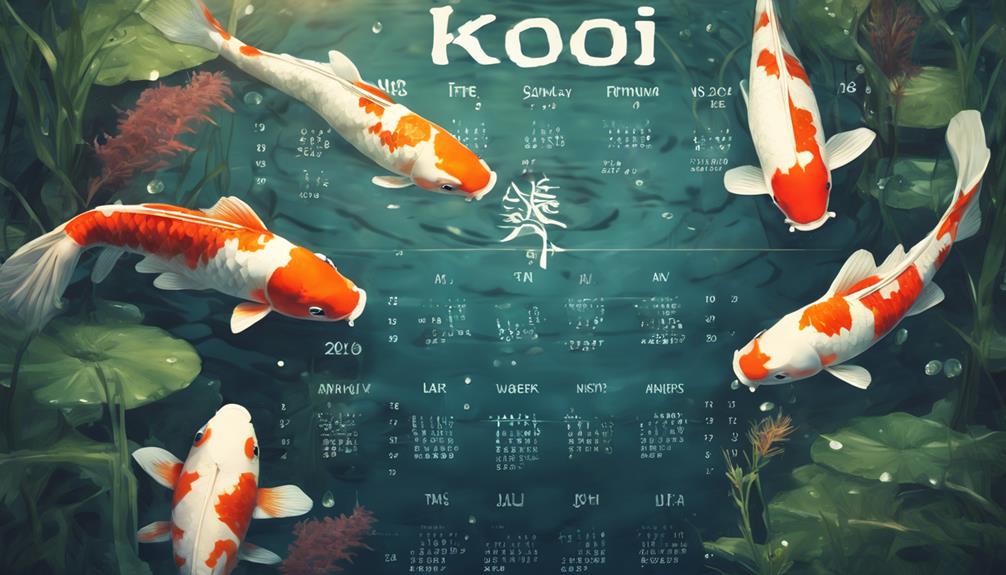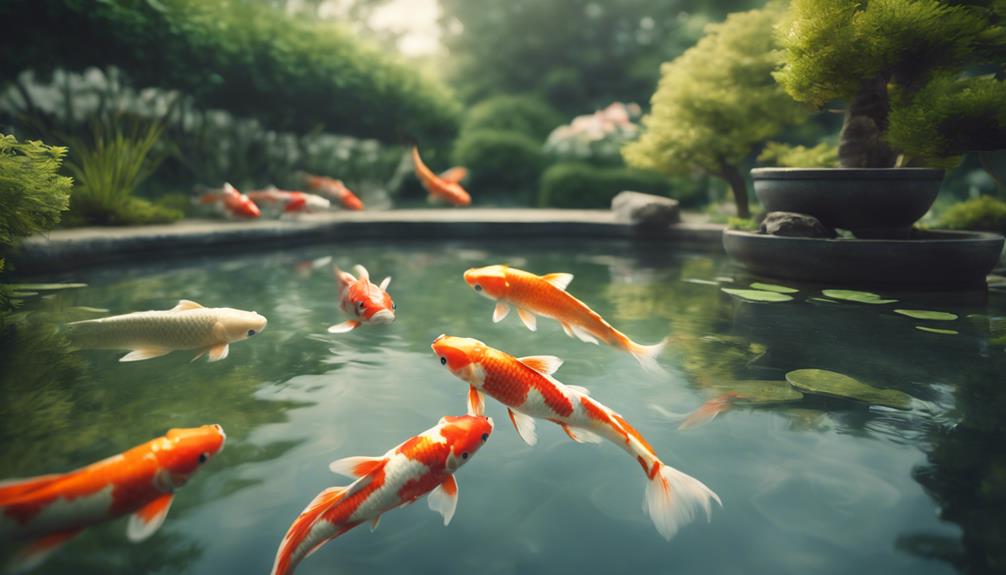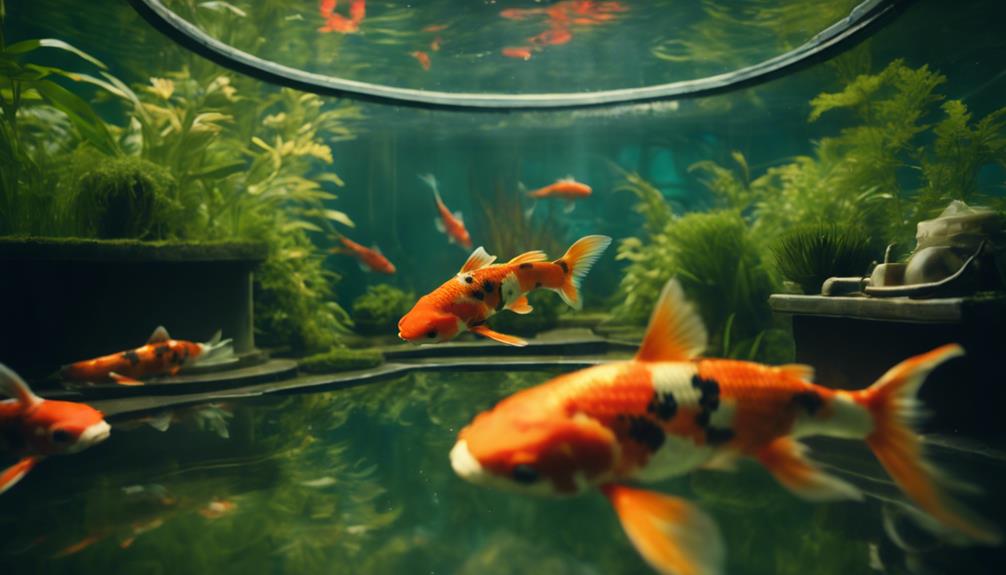You'll increase your chances of producing show-quality Koi fish by following these best practices: guarantee precise water temperature control and ideal water quality, achieved through a reliable filtration system and regular water changes. Understand the biology and behavior of your fish, including their reproductive cycles and nutritional needs. Prepare dedicated ponds and live food, such as Brine shrimp, to support the growth and development of baby Koi. Time and coordinate breeding carefully, using hormone injections and monitoring for signs of readiness. Finally, select breeders with exceptional genetic traits and provide them with a balanced diet. From here, the nuances of Koi breeding will come into focus.
Table of Contents
Key Takeaways
- Maintaining ideal water parameters, such as pH, ammonia, and nitrite levels, is crucial for a healthy environment in Koi breeding.
- Selecting breeders with exceptional genetic traits and peak health is pivotal in producing high-quality Koi fish with stunning colors and patterns.
- Hormone injections and monitoring the vent area for signs of readiness are essential for successful and timely breeding.
- Providing high-quality food, such as brine shrimp or commercial fry food, supports rapid growth and development of fry.
- Frequent water changes (up to 50% every 24 hours) prevent disease and maintain prime water quality for optimal fry growth.
Debunking Koi Breeding Misconceptions
You may think that breeding Koi fish is a straightforward process, but nothing could be further from the truth.
In reality, it requires specific conditions and careful planning to produce high-quality Japanese Koi fish that can win a Koi Show or even become a Grand Champion.
The breeding season is critical, and water temperature plays a significant role in the success of the breeding process.
Experienced Koi breeders understand that water quality is paramount, and a reliable filtration system is essential to maintain ideal water conditions.
Breeding fish isn't just about putting a male and female together; it demands a deep understanding of the biology and behavior of the fish, including their reproductive cycles, nutritional needs, and environmental requirements.
With a large Koi capable of producing up to half a million eggs, it's easy to assume that breeding is a numbers game, but the truth is that only a small percentage of eggs will survive to become healthy, high-quality fish.
Preparing Ponds and Live Food
Your pond's water chemistry and quality play a pivotal role in the success of your Koi breeding program, so making provision for it in advance of the breeding season is imperative. Preparing your ponds involves maintaining ideal water parameters, such as pH, ammonia, and nitrite levels, to guarantee a healthy environment for your quality Japanese koi.
In addition to a well-maintained pond, live food is necessary for the growth and development of your baby koi. You should have a steady supply of nutritious live foods, such as Brine shrimp, to feed your fry as they grow. A dedicated Quarantine Tank is also indispensable for isolating and treating any sick or stressed fish, preventing the spread of disease to your entire Koi Garden.
During the spawning process, it's imperative to provide a safe and stress-free environment for your koi. This includes maintaining a clean and well-oxygenated pond, as well as providing plenty of hiding places and plants for your fish to feel secure. By focusing on preparing your ponds and live food, you'll be well on your way to successful Show Preparation and raising top-quality koi that will thrive and impress.
Timing and Coordinating Breeding

Timing and coordinating breeding are critical components of a successful Koi breeding program, requiring precise synchronization of mud pond preparation, fertilization, and live food cultivation to create an ideal environment for spawning.
When raising champion koi, you need to guarantee that your quality Japanese koi fish are ready to breed at the same time. Weather conditions, such as sufficient warmth and sunlight, are necessary for fermentation and blooms.
Hormone injections are used to induce ovulation in females, and you'll need to monitor their vent area for signs of readiness, such as swelling and a pinkish color.
Using a microscope, you'll examine egg samples obtained through a catheter inserted in the vent to determine the female's readiness to spawn. The more off-center the nucleus, the more ready the female is to spawn.
Fry Growth and Water Quality
Fry growth explodes during the first few weeks, making it crucial to maintain pristine water quality and prevent the buildup of toxic compounds like ammonia and nitrite.
As a responsible breeder, you must prioritize the health and well-being of your koi fry.
To guarantee peak growth and development, follow these essential guidelines:
- Maintain ideal water temperature: Keep the water temperature between 76°F and 82°F (24°C and 28°C) to promote healthy fry growth.
- Provide high-quality food: Feed your fry nutrient-rich foods like brine shrimp or commercial fry food to support their rapid growth and development.
- Perform frequent water changes: Change up to 50% of the water every 24 hours to prevent disease and maintain prime water quality.
- Monitor for signs of stress or disease: Inspect your fry daily for signs of stress, disease, or deformities, and cull accordingly to prevent the spread of disease and improve the overall quality of the remaining fry.
Selecting and Caring for Breeders

Selecting breeders with exceptional genetic traits and peak health is a pivotal step in producing high-quality koi fish that excel in color, pattern, and body conformation.
You'll want to choose breeders that are at least 3 years old, as they're sexually mature and can produce healthy offspring. When selecting breeders, look for stunning colors, unique patterns, and excellent body conformation, characteristic of quality Japanese koi.
To keep your breeders in top condition, provide a healthy diet with a balanced mix of protein, vitamins, minerals, and carbohydrates.
Also, maintain excellent water quality by regularly testing pH, ammonia, and nitrate levels. This will prevent disease and stress, safeguarding the health and well-being of your breeders.
Don't forget to quarantine new breeders before introducing them to your existing koi population. This essential step prevents the spread of disease and guarantees the health of your entire koi population.
Frequently Asked Questions
How Do You Breed a Koi Successfully?
You breed koi successfully by selecting superior fish, controlling water quality, and implementing precise feeding strategies, then inducing spawn through hormonal or natural means, while ensuring genetic diversity and ideal environment control.
What Makes a Koi Show Quality?
You're looking for a show-stopper! A koi's show quality is determined by its conformation, fin quality, scale shine, body shape, color intensity, pattern uniqueness, size proportion, swimming style, fins symmetry, and head shape – all of which you'll need to perfect.
How to Prepare Koi for Koi Show?
You're preparing koi for a show like a master chef perfects a recipe, and it starts with selecting top-tier koi, ensuring impeccable water quality, and meticulously preparing the tank, all while honing fish handling and show training skills.
How to Encourage Koi Spawning?
To encourage koi spawning, you'll need to create an ideal environment by manipulating Spawning Triggers, maintaining excellent Water Quality, and stabilizing pH Levels in your Breeding Ponds, using Spawning Mats and Natural Stimulation.
Conclusion
As you plunge into the world of show-quality koi fish breeding, remember that mastery is a symphony of precision and patience.
By debunking misconceptions, preparing ponds and live food, timing breeding, nurturing fry, and selecting elite breeders, you'll be orchestrating a masterpiece of vibrant scales and majestic fins.
With every carefully executed step, you'll be one stroke closer to creating a work of art that will make judges and enthusiasts alike take notice.

